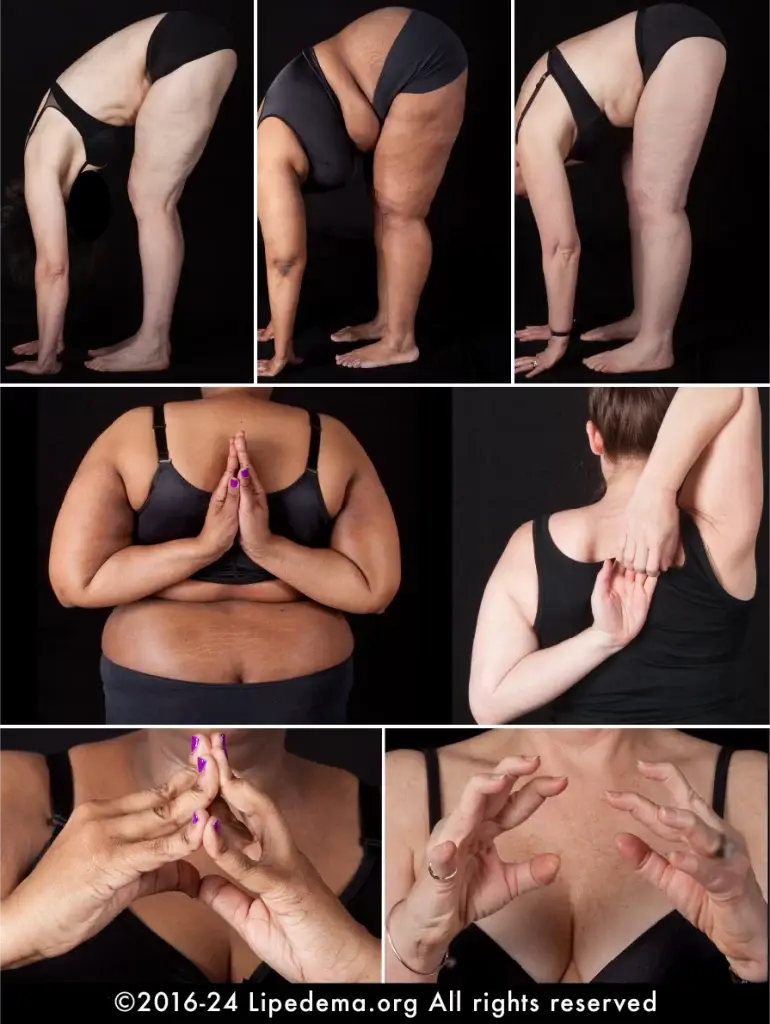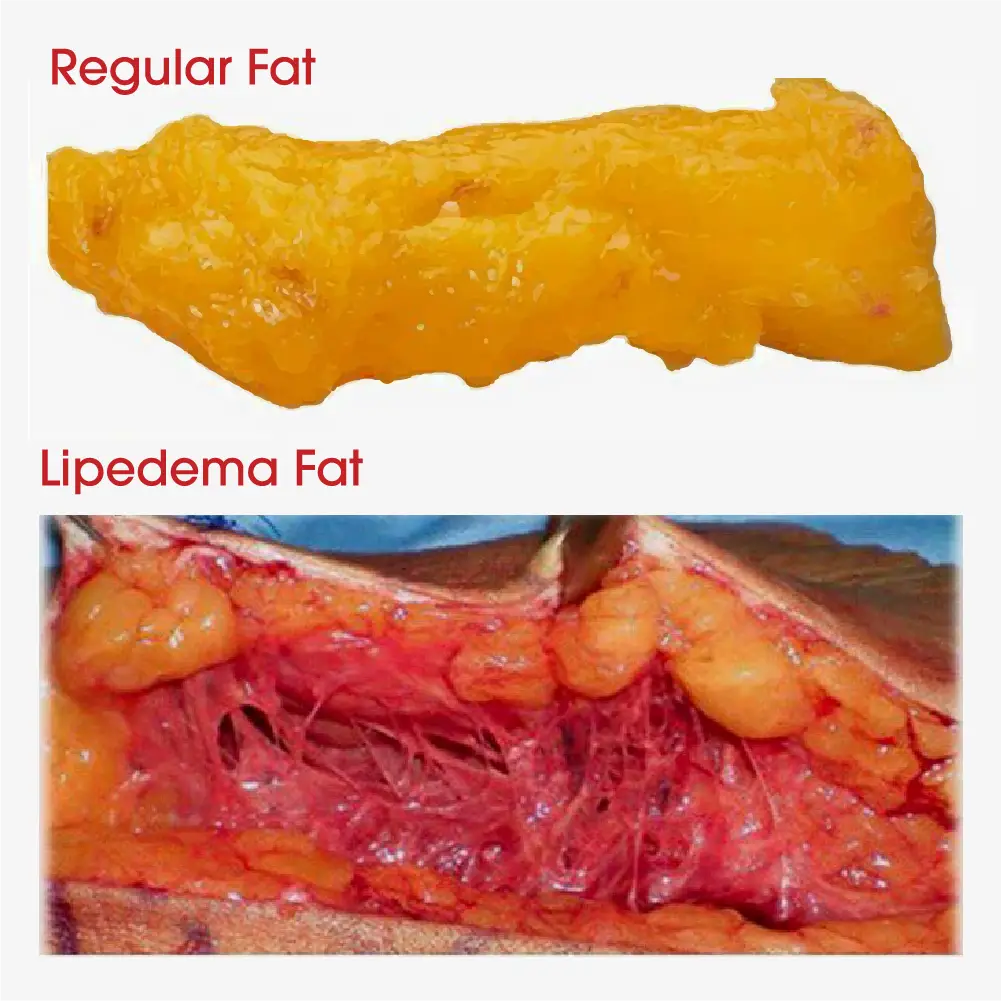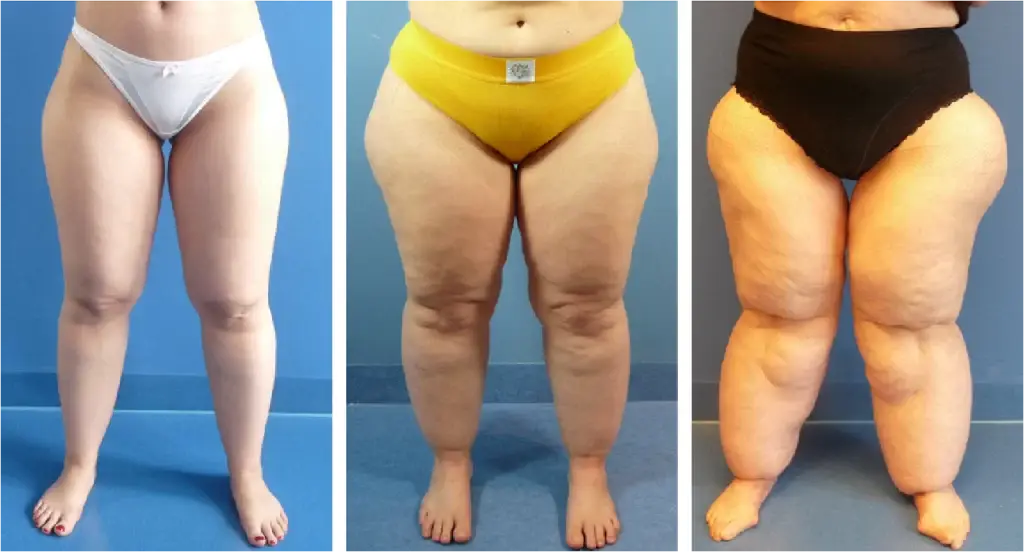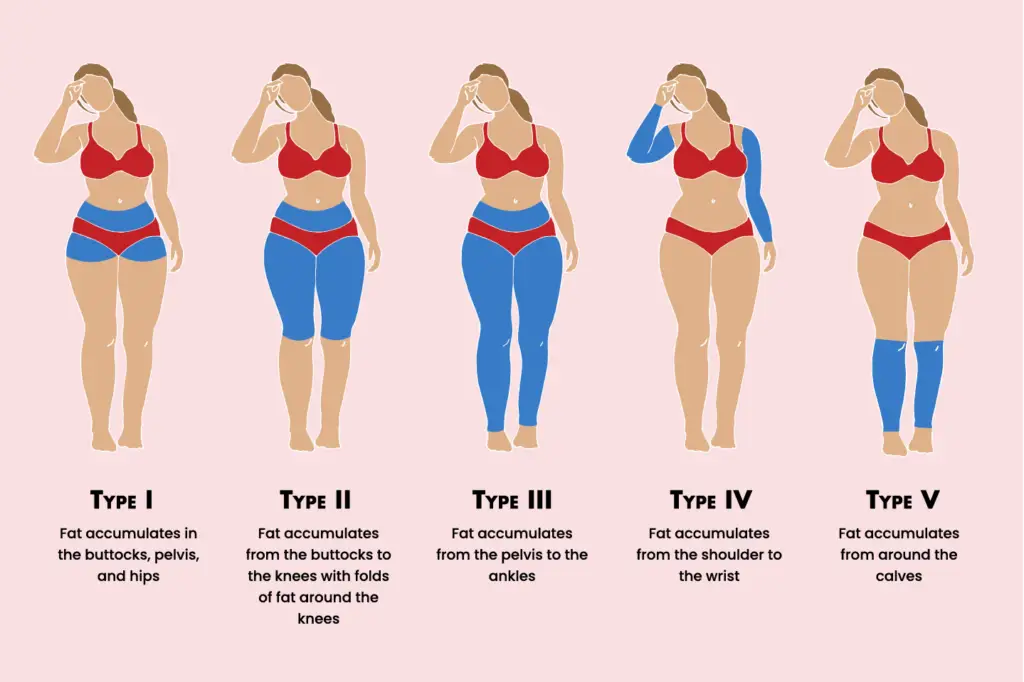Supporting those with Lipedema
Thank you for investing in our shared pursuit of knowledge and for supporting the lipedema community.
For the latest scholarly resources on lipedema, please visit the Legato Lipedema Research Library created and managed by our colleagues at The Lipedema Foundation.
Our colleagues at The Lipedema Foundation have an excellent clinician’s guide resource available for download and free order via mail. This quick reference can be used to support clinicians in the clinical setting, helping them make a diagnosis and connect patients with the right resources in the community. Please visit the link below to access the clinician’s guide.
Lipedema necessitates a clinical diagnosis, as there is currently no standardized test, such as bloodwork, or imaging, that can definitively confirm its presence. Diagnosis should be achieved within the framework of a comprehensive patient history and physical examination.
Learn more about patient history and physical examination for lipedema in these videos:
Clinicians should complete a detailed history with the patient, taking note if the following symptoms are reported:
(Note that lipedema can present several symptom variations, e.g., cuffing/no cuffing, as well as in varied degrees of severity regarding pain and dysfunction.)
• Family member(s) with similar body type – lipedema is believed to be genetic
• Difficulty losing fat in affected areas
• Onset/worsening at periods of hormonal change (puberty, pregnancy, menopause, use of hormonal birth control)
• Pain, tenderness, heaviness in affected areas
• Mild orthostatic edema (worse after long period of standing or at the end of the day, often resolving overnight)
• Fatigue
• Tendency to bruise easily
• History of joint issues including hypermobility
• Decreased functional ability (including mobility)
• Decreased quality of life
• Limited or no response to interventions including:
Swelling: The affected areas may appear swollen or puffy. Swelling is usually worse after a long periods of standing or toward the end of the day.
Tenderness: The fat deposits can be tender or painful to the touch.
Easy bruising: The skin may bruise easily, even with minor trauma.
Symmetry: Lipedema typically affects both sides of the body equally.
Cold Skin: Skin that is cool to the touch in affected areas.
Impacts mobility: Lipedema can lead to decreased mobility (painful walking, difficulty standing) and decreased quality of life.
Hypermobility is often present: flexible joints and increased range of motion.
As with most conditions, the intensity of symptoms varies from person to person, mild in some, and severe in others. Pain and dysfunction can be present at all stages.

Visual Inspection:
Palpation:
Nodular and/or fibrotic texture in affected areas:
Healthcare professionals commonly identify lipedema by the texture of the subcutaneous fat. Lipedema fat can range in texture from having grains of sand or rice in it to feeling like frozen peas in a bag or even larger nodules. Lipomas may even be as large as a grapefruit. Nodules can vary in size from a few millimeters to a few centimeters and are typically spheroidal, although clusters may give the sense of oblong or rod-like shapes. These features can greatly vary between patients in terms of size, texture, and depth within the tissue, making them difficult to feel, especially if swelling is present.

Pain/tenderness in affected areas:
Patients may report pain from having their blood pressure checked, or having pets or small children walk across their laps. The degree of pain and tenderness is not alway directly correlated with disease progression. Some patients in the early stages of lipedema also report significant pain and impairment.
Flat feet, pronated ankles, and lipomas on the ankles:
Flat feet and pronated ankles are common features associated with both lipedema and other conditions. In individuals with flat feet (pes planus), the arch of the foot is lower than normal or even completely collapsed, causing the entire sole of the foot to come into contact with the ground when standing. Pronated ankles occur when the ankles roll inward and the arches of the feet collapse excessively, often leading to an altered gait pattern and potential discomfort or pain in the feet, ankles, knees, hips, or lower back.
In lipedema, flat feet and pronated ankles can occur as secondary effects due to the increased weight and pressure placed on the lower extremities from the disproportionate accumulation of fat. The excess fat tissue in the legs and around the ankles can contribute to biomechanical changes, leading to conditions like flat feet and pronated ankles.
Ankle lipomas are benign fatty tumours that can develop in various parts of the body, including the ankles. In lipedema, ankle lipomas may occur as a result of the abnormal distribution of fat tissue characteristic of the condition. These lipomas typically appear as soft, rubbery lumps beneath the skin and may vary in size. While ankle lipomas themselves may not cause significant symptoms or complications, they can contribute to the overall discomfort experienced by individuals with lipedema due to their presence in an already affected area.
It’s essential for individuals with lipedema experiencing foot or ankle issues such as flat feet, pronated ankles, or ankle lipomas to consult with healthcare professionals, such as podiatrists or orthopaedic specialists, for appropriate evaluation, management, and treatment options tailored to their specific needs.
Cutaneous hypothermia: Skin in affected areas tends to be cold to the touch
Negative Stemmers Sign:
The Stemmer Sign is a physical examination finding used to diagnose lymphedema. If the examiner cannot pinch the skin of the dorsum of the foot or hand then this positive finding is associated with lymphedema.

‘Stage’ refers to the advancement of symptoms and progression of the disease. Pain and dysfunction can be present at every stage and body size.
Stage 1: Skin has a smooth texture with a pebble-like feel beneath the skin due to underlying loose connective tissue fibrosis.
Stage 2: Patients have more lipedema tissue than those with Stage 1. Skin is now dimpling (appears like cellulite) due to progressed fibrotic changes and excess tissue. Palpable nodules may be larger and more numerous.
Stage 3: Significantly increased lipedema tissue, more fibrotic in texture, with numerous large nodules beneath the skin. Overhanging lobules of tissue now change the normal anatomy of the affected areas.

‘Types’ of lipedema refer to the areas of the body affected by lipedema fat accumulation.
Lipedema has five main types and often people with lipedema may have a combination of types. For example: Type III/IV is a person who is affected by lipedema from the pelvis to the ankles as well as the arms. Many persons with lipedema do not fit neatly into just one category.
Type I:
Fat accumulation in the buttocks, pelvis, and hips
Type II:
Fat accumulation from the buttocks to the knees with folds of fat around the knees (medial knee fat pads)
Type III:
Fat accumulates from the pelvis to the ankles
Type IV:
Fat accumulates from the shoulder to the wrist
Type V:
Fat accumulates around the calves

Clinicians should complete a detailed history with the patient, taking note if the following symptoms are reported:
(Note that lipedema can present several symptom variations, e.g., cuffing/no cuffing, as well as in varied degrees of severity regarding pain and dysfunction.)
• Family member(s) with similar body type – lipedema is believed to be genetic
• Difficulty losing fat in affected areas
• Onset/worsening at periods of hormonal change (puberty, pregnancy, menopause, use of hormonal birth control)
• Pain, tenderness, heaviness in affected areas
• Mild orthostatic edema (worse after long period of standing or at the end of the day, often resolving overnight)
• Fatigue
• Tendency to bruise easily
• History of joint issues including hypermobility
• Decreased functional ability (including mobility)
• Decreased quality of life
• Limited or no response to interventions including:
Swelling: The affected areas may appear swollen or puffy. Swelling is usually worse after a long periods of standing or toward the end of the day.
Tenderness: The fat deposits can be tender or painful to the touch.
Easy bruising: The skin may bruise easily, even with minor trauma.
Symmetry: Lipedema typically affects both sides of the body equally.
Cold Skin: Skin that is cool to the touch in affected areas.
Impacts mobility: Lipedema can lead to decreased mobility (painful walking, difficulty standing) and decreased quality of life.
Hypermobility is often present: flexible joints and increased range of motion.
As with most conditions, the intensity of symptoms varies from person to person, mild in some, and severe in others. Pain and dysfunction can be present at all stages.

Visual Inspection:
Palpation:
Nodular and/or fibrotic texture in affected areas:
Healthcare professionals commonly identify lipedema by the texture of the subcutaneous fat. Lipedema fat can range in texture from having grains of sand or rice in it to feeling like frozen peas in a bag or even larger nodules. Lipomas may even be as large as a grapefruit. Nodules can vary in size from a few millimeters to a few centimeters and are typically spheroidal, although clusters may give the sense of oblong or rod-like shapes. These features can greatly vary between patients in terms of size, texture, and depth within the tissue, making them difficult to feel, especially if swelling is present.

Pain/tenderness in affected areas:
Patients may report pain from having their blood pressure checked, or having pets or small children walk across their laps. The degree of pain and tenderness is not alway directly correlated with disease progression. Some patients in the early stages of lipedema also report significant pain and impairment.
Flat feet, pronated ankles, and lipomas on the ankles:
Flat feet and pronated ankles are common features associated with both lipedema and other conditions. In individuals with flat feet (pes planus), the arch of the foot is lower than normal or even completely collapsed, causing the entire sole of the foot to come into contact with the ground when standing. Pronated ankles occur when the ankles roll inward and the arches of the feet collapse excessively, often leading to an altered gait pattern and potential discomfort or pain in the feet, ankles, knees, hips, or lower back.
In lipedema, flat feet and pronated ankles can occur as secondary effects due to the increased weight and pressure placed on the lower extremities from the disproportionate accumulation of fat. The excess fat tissue in the legs and around the ankles can contribute to biomechanical changes, leading to conditions like flat feet and pronated ankles.
Ankle lipomas are benign fatty tumours that can develop in various parts of the body, including the ankles. In lipedema, ankle lipomas may occur as a result of the abnormal distribution of fat tissue characteristic of the condition. These lipomas typically appear as soft, rubbery lumps beneath the skin and may vary in size. While ankle lipomas themselves may not cause significant symptoms or complications, they can contribute to the overall discomfort experienced by individuals with lipedema due to their presence in an already affected area.
It’s essential for individuals with lipedema experiencing foot or ankle issues such as flat feet, pronated ankles, or ankle lipomas to consult with healthcare professionals, such as podiatrists or orthopaedic specialists, for appropriate evaluation, management, and treatment options tailored to their specific needs.
Cutaneous hypothermia: Skin in affected areas tends to be cold to the touch
Negative Stemmers Sign:
The Stemmer Sign is a physical examination finding used to diagnose lymphedema. If the examiner cannot pinch the skin of the dorsum of the foot or hand then this positive finding is associated with lymphedema.

‘Stage’ refers to the advancement of symptoms and progression of the disease. Pain and dysfunction can be present at every stage and body size.
Stage 1: Skin has a smooth texture with a pebble-like feel beneath the skin due to underlying loose connective tissue fibrosis.
Stage 2: Patients have more lipedema tissue than those with Stage 1. Skin is now dimpling (appears like cellulite) due to progressed fibrotic changes and excess tissue. Palpable nodules may be larger and more numerous.
Stage 3: Significantly increased lipedema tissue, more fibrotic in texture, with numerous large nodules beneath the skin. Overhanging lobules of tissue now change the normal anatomy of the affected areas.

‘Types’ of lipedema refer to the areas of the body affected by lipedema fat accumulation.
Lipedema has five main types and often people with lipedema may have a combination of types. For example: Type III/IV is a person who is affected by lipedema from the pelvis to the ankles as well as the arms. Many persons with lipedema do not fit neatly into just one category.
Type I:
Fat accumulation in the buttocks, pelvis, and hips
Type II:
Fat accumulation from the buttocks to the knees with folds of fat around the knees (medial knee fat pads)
Type III:
Fat accumulates from the pelvis to the ankles
Type IV:
Fat accumulates from the shoulder to the wrist
Type V:
Fat accumulates around the calves

The International Classification of Diseases (ICD) is a standardized code set that enables healthcare professionals to record and share health data worldwide.
The World Health Organization updates the ICD periodically, and in 2019, Lipedema was recognized as a distinct disease entity with its own specific code in the 11th revision. Unfortunately, Canada cannot utilize this code yet and still relies on the ICD codes from the 9th and 10th revision, depending on the province. Lipedema Canada is currently seeking to include the coding for lipedema.
Below are the most commonly used ICD-10 codes at present (as reported by clinicians according to Lipedema Foundation):
ICD-11, which was adopted in 2019, includes a specific global ICD code for Lipedema for the first time:
Please note that as of May 2022, 35 countries have begun using ICD-11 codes, but each country is responsible for adopting and implementing the new codes in its own health system.
Furthermore, the Federal Institute for Drugs and Medical Devices (BfArM) in Germany has adopted several specific ICD-10 codes for Lipedema that are not used in the USA or Canada:
– E88.21 Lipedema, stage 1
– E88.22 Lipedema, stage 2
– E88.23 Lipedema, stage 3
– E88.24 Lipedema, other
Source: Lipedema Foundation www.lipedema.org
Limited understanding among clinicians regarding lipedema can lead to patients being corrected when they mention their condition and clinicians saying “lymphedema?” when in fact they mean lipedema. Understanding the differences between lipedema and lymphedema, as well as acknowledging that lipedema is not obesity, is crucial for providing appropriate care.
Conservative Measures for Lipedema:
Conservative or non invasive for managing and treating lipedema focus on reducing symptoms and improving quality of life. These measures include:
Compression Therapy: Wearing flat-knit custom-measured compression garments can help reduce swelling and improve lymphatic flow. Graduated compression stockings or bandages are commonly used. Class II (30-40 mmHg) full pantyhose covering from the toes to the belly button is the recommendation for lipedema management.
Manual Lymphatic Drainage (MLD): This specialized massage technique can help stimulate the lymphatic system and reduce swelling. MLD is often provided by physiotherapists, massage therapists, nurses, or occupational therapists trained in lipedema and lymphedema care by an accredited program.
Exercise: Low-impact exercises such as walking, swimming, or cycling can help improve circulation and lymphatic flow. A physical therapist can provide guidance on suitable exercises. The goals are to get the lymphatic system moving, take care of your joints if you are hypermobile, and build strength to help combat extra weight.
Anti-Inflammatory Diet: Keto, RAD (rare adipose diet), low-carb or Mediterranean ways of eating can help maintain a healthy weight and reduce inflammation.
Weight Management: While lipedema is not caused by obesity, maintaining a healthy weight through diet and exercise can help reduce the strain on the lymphatic system.
Psychological Support: Living with lipedema can be challenging; counseling or support groups can be beneficial in managing the emotional impact of the condition.
It’s important to consult with a healthcare professional before starting any new treatment regimen, as they can provide personalized recommendations based on individual needs.
Surgical Treatment for Lipedema:
Surgical treatment (Lipedema Reduction Surgery – LRS) typically involves non-cosmetic liposuction, which aims to remove excess fat deposits in affected areas. Lipedema Reduction Surgery can be a useful tool to reduce pain, improve mobility, and improve quality of life for lipedema patients.
• Prescription for compression garments: Often flat-knit, class II, custom measured garments are recommended for lipedema
• Certified Lymphedema/Lipedema Therapists for Manual Lymphatic Drainage (MLD) and Combined Decongestive Therapy (CDT)
• Registered dieticians to develop an anti-inflammatory eating plan
• Obesity medicine specialists to address any obesity-related comorbidities
• Vascular specialists to assess for any vascular disease
• Qualified lipedema surgeons for specialized surgical options; consults to international board-certified lipedema plastic surgeons are often made for those patients requiring surgery due to a lack of Canadian qualified providers at present
• Mental health professionals to provide support for mental health and quality of life challenges
• Support groups like Lipedema Canada on Facebook to connect with others for support
Our diagnosis letter aims to provide clarity on the official lipedema diagnosis. It can aid your patients in securing private insurance coverage for conservative treatments and enable them to claim additional medical expenses on their tax returns with ease.
Click below to download the sample diagnosis letter.
Our sample letter of medical necessity helps to take the mystery out of what information is often required for lipedema. This tool can serve as a guide for your care provider when they write letters of support for lipedema patients.
Click below to download the sample letter of medical necessity.
Disclaimer: Lipedema Canada is not a medical provider. This guide is for informational purposes only and is not intended to substitute for professional medical advice, diagnosis, or treatment. Seek the advice of your physician regarding a medical condition or treatment before undertaking any new healthcare regimen.